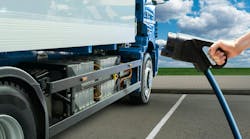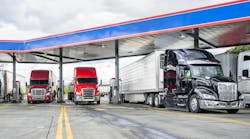WASHINGTON, DC.- Government and industry experts joined forces here to call for more support of clean diesel technology initiatives to address U.S. environmental, energy security, and transportation needs.
“Fuel efficiency is what drives this market for diesel power, but we need to bring more ‘clean diesel’ technology to the fore to protect public health,” said Gina McCarthy, assistant administrator-air and radiation for the Environmental Protection Agency, in remarks at the Clean Diesel Technology showcase held at the Ronald Reagan Building yesterday.
“We need more financial tools to allow smaller trucking companies, for example, to keep up with the ‘big guys’ in purchases cleaner commercial trucks,” she noted. “Such tools will help us replace the ‘legacy fleet’ of older diesel equipment that generates more pollution.”
McCarthy pointed out that the “clean diesel” technology on display around her – including a Caterpillar diesel-electric hybrid bulldozer, Navistar hybrid school bus, and Volvo, Mack, and Freightliner-brand commercial trucks equipped with selective catalytic reduction (SCR) systems and diesel particulate filters (DPFs) – represent green technology that is largely without tradeoffs.
“All of them offer reduced fuel pollution yet greater fuel efficiency,” she stressed. “We’re not faced with the issue of balancing business and environmental interests with these technological advances.”
“Diesel powers key sectors of the U.S. economy – yet it’s important to note diesel technology is evolving to meet the future needs and will play vital role in our energy and environmental strategy for the future,” said Allen Schaeffer, executive director of the Diesel Technology Forum, which hosted the event.
“A new generation of clean diesel technology is already in place that uses a combination of ultra-low sulfur diesel fuel, more fuel-efficient diesel engines, and highly effective emissions control devices,” he said. “Diesel’s unsurpassed energy efficiency enhances America’s energy security by reducing our reliance on oil imports as more ‘clean diesel’ vehicles are added to the nation’s fleets.”
Rich Scheckells, vp-environment for the Maryland Ports Administration, noted that the ongoing challenge facing the U.S. is how to minimize the environmental impact of a largely diesel-based transportation system that must work nonstop, 24 hours a day, 365 days a year.
“Just look at the Port of Baltimore, MD, to see the role diesel power plays,” he noted. “Diesel powers the cargo ships that bring goods into the port; it powers the dock equipment that takes the cargo off the ship; and it powers the railroad locomotives and trucks that move the cargo from the docks to its final destination. So the goal is to get cargo and consumer goods moved in the U.S. in a timely and cost efficient way but with a smaller environmental footprint.”
To do that requires a range of incentives, said Scheckells, to encourage the broader adoption of clean diesel technology. For example, he pointed to a new initiative by the State of Maryland’s environmental department to provide funds to port drayage truck operators to buy clean diesel equipment.
“Diesel has long been a workhorse for business because of its greater power density and low cost of operation,” Tana Utley, vp & CTO of Caterpillar, pointed out. “But now we are making them ‘cleaner’ workhorses so they can be part of the clean air solution,” she said. “It will also require broader thinking, not just about new diesel engines but about retrofit programs and fuel consumption. It will require us to look beyond diesel engines alone to the vehicles and infrastructure that rely on them.
“That means our government, industry, and universities must collaborate more to help in this continuing quest for improvement when it comes to the environmental impact of diesel power,” Utley added.




